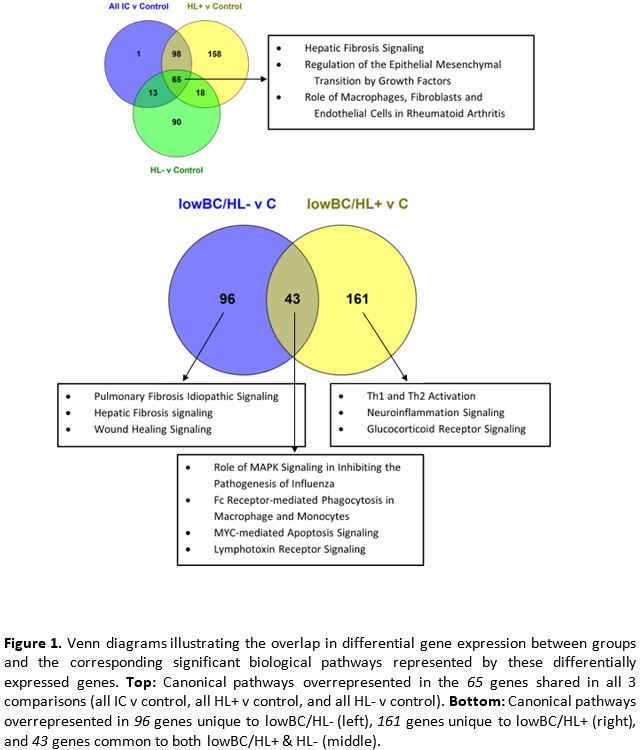Back
Poster, Podium & Video Sessions
Moderated Poster
MP49: Urodynamics/Lower Urinary Tract Dysfunction/Female Pelvic Medicine: Basic Research & Pathophysiology
MP49-13: Bladder-centric interstitial cystitis/bladder pain syndrome patients exhibit a variable bladder mucosal fibrosis-related gene expression profile based on Hunner's lesion status
Sunday, May 15, 2022
4:30 PM – 5:45 PM
Location: Room 228
Dylan T. Wolff*, Raymond Xu, Sarah Wachtman, Robert J. Evans, Gopal Badlani, Catherine A. Matthews, Stephen J. Walker, Winston-Salem, NC

Dylan T. Wolff, MD
Atrium Health Wake Forest Baptist
Poster Presenter(s)
Introduction: The concept of disease progression in interstitial cystitis/bladder pain syndrome (IC/BPS) is somewhat enigmatic in that only ~10% of (typically older) patients appear to progress to a bladder-centric phenotype. The objective of this study was to examine fibrosis-related gene expression profiles in bladder mucosa from a heterogeneous cohort of IC/BPS patients, both bladder-centric and non-bladder-centric, to determine if subgroup-specific patterns suggestive of disease progression were apparent.
Methods: Bladder mucosal biopsies were collected from 48 females (32 IC/BPS patients; 16 non-IC/BPS controls); IC/BPS patients were further divided into two groups based on anesthetic bladder capacity (BC) =400cc (low; N=16) or >400cc (non-low; N=16). Within each BC subgroup, one-half of the patients were Hunner’s lesion positive (HL+) and the other half were HL-. Following RNA isolation and quality assessment, gene expression was measured using the nCounter Fibrosis Panel (Nanostring), that allows for profiling 770 genes across 51 annotated pathways involved in the four stages of fibrosis (initiation, inflammation, proliferation, and modification). Comparisons were made between: (1) all IC v control, (2) all HL+ v control, and (3) all HL- v control. Subgroup analyses compared bladder-centric (i.e., low BC) IC patients +/- HL.
Results: Overall, in the comparisons of gene expression in mucosal specimens from IC/BPS patients to non-IC/BPS controls, there was a statistically significant overrepresentation of genes involved in fibrosis signaling, disruption of tight junctions and reorganization of the actin cytoskeleton, and infiltration of inflammatory cells (Figure 1 - top). In the comparisons between samples from bladder-centric patients (low BC) only, with and without HL, the HL- gene expression profile was representative of fibrosis signaling and wound healing signaling while the HL+ profiles were representative of immune cell activation and inflammatory response (Figure 1 – bottom).
Conclusions: The preliminary data presented here suggest the etiology of disease progression in IC/BPS to a bladder-centric phenotype likely involves pathophysiological fibrotic processes beyond a finding of Hunner’s lesions.
Source of Funding: 1R01DK124599-01, R21DK106554-01

Methods: Bladder mucosal biopsies were collected from 48 females (32 IC/BPS patients; 16 non-IC/BPS controls); IC/BPS patients were further divided into two groups based on anesthetic bladder capacity (BC) =400cc (low; N=16) or >400cc (non-low; N=16). Within each BC subgroup, one-half of the patients were Hunner’s lesion positive (HL+) and the other half were HL-. Following RNA isolation and quality assessment, gene expression was measured using the nCounter Fibrosis Panel (Nanostring), that allows for profiling 770 genes across 51 annotated pathways involved in the four stages of fibrosis (initiation, inflammation, proliferation, and modification). Comparisons were made between: (1) all IC v control, (2) all HL+ v control, and (3) all HL- v control. Subgroup analyses compared bladder-centric (i.e., low BC) IC patients +/- HL.
Results: Overall, in the comparisons of gene expression in mucosal specimens from IC/BPS patients to non-IC/BPS controls, there was a statistically significant overrepresentation of genes involved in fibrosis signaling, disruption of tight junctions and reorganization of the actin cytoskeleton, and infiltration of inflammatory cells (Figure 1 - top). In the comparisons between samples from bladder-centric patients (low BC) only, with and without HL, the HL- gene expression profile was representative of fibrosis signaling and wound healing signaling while the HL+ profiles were representative of immune cell activation and inflammatory response (Figure 1 – bottom).
Conclusions: The preliminary data presented here suggest the etiology of disease progression in IC/BPS to a bladder-centric phenotype likely involves pathophysiological fibrotic processes beyond a finding of Hunner’s lesions.
Source of Funding: 1R01DK124599-01, R21DK106554-01

.jpg)
.jpg)